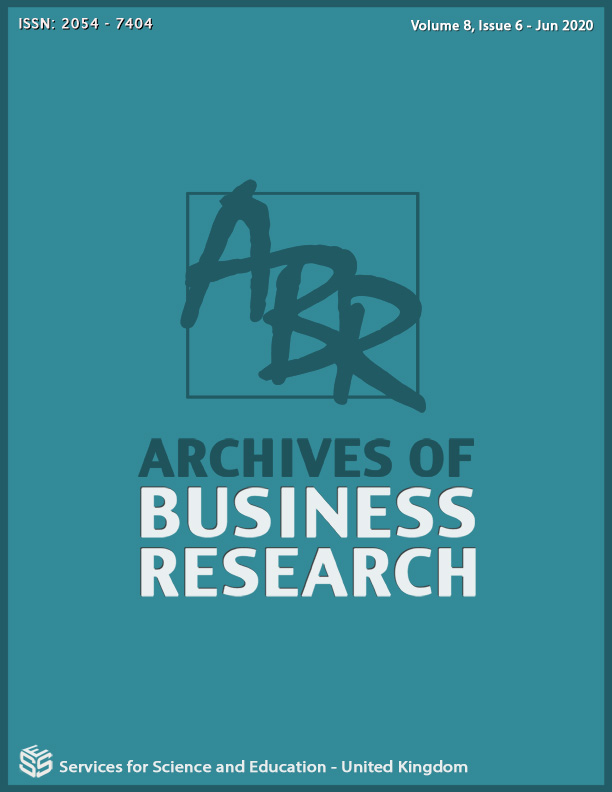Artificial Neural Network Approach for Business Decision Making applied to a Corporate Relocation Problem
DOI:
https://doi.org/10.14738/abr.86.8202Keywords:
Artificial Neural Networks; Corporate Relocation; Multiple Criteria; Decision MakingAbstract
This paper presents a new Artificial Neural Network approach to making a business decision. A corporate relocation problem is considered as an example for a business decision and the new approach is applied to select a city for corporate relocation and to rank a set of potential alternatives. Selecting the location of corporate real estate can be key to optimizing an organization’s success. This is the first time Artificial Neural Networks have been used for this sort of business application. The Neural Network behaved satisfactorily and provided 91.76% accuracy when tested against randomly generated test sets. Five potential cities were considered: New York City, Washington D.C. Atlanta, Los Angeles and Portland. Decision makers identified six criteria: Financial Considerations Employee Availability, Support Services, Cultural Opportunities, Leisure Activities, and Climate. A suitable city is recommended that provides an appropriate solution and the outcome of the new approach is also used to rank potential cities based on their suitability.
References
[2]. Oladokun, T., Corporate site selection and acquisition in a Nigerian GSM communication company, Journal of Corporate Real Estate, 2011, 13(4), p.247-260.
[3]. Glatte, T., Location Strategies: Methods and their methodological limitations, Journal of Engineering Design and Technology, 2015, 13(3), p. 435 – 462.
[4]. Christersson, M. and P. Rothe, Impacts of organizational relocation: a conceptual Framework, Journal of Corporate Real Estate, 2012, 14(4), p.226-243.
[5]. Hassanain, M.A., et al., Weighted Evaluation Method for Corporate Real Estate Site Selection in Saudi Arabia, Journal of Urban Planning and Development, 2018, 144(1), p.05017012.
[6]. Arkesteijn, M., et al., Improving decision making in CRE alignment, by using a preference-based accommodation strategy design approach, Journal of Corporate Real Estate, 2017, 19(4), p.239-264.
[7]. Cumming, D., et al., Corporate Relocation in Venture Capital Finance, Entrepreneurship Theory and Practice, 2009, 33(5), p. 1121 – 1155.
[8]. Barcena-Ruiz, J. C. and M. B. Garzon, Relocation and investment in R and D by firms, Portuguese Economic Journal, 2014, 13(1), p. 25–38.
[9]. Brouwer, A., et al., The firm relocation decision: An empirical Investigation. Annals of Regional Science, 2004, 38(2), p. 335–347.
[10]. Christersson, M., et al., Social impacts of a short-distancerelocation process and new ways of working, Journal of Corporate Real Estate 2017, 19(4), p. 65-284.
[11]. Rothe, P. and C. Heywood, Demystifying the short-distance relocation process: 5 cases from Finland, Journal of Corporate Real Estate. 2015, 17(1), p. 160-177.
[12]. Hochreiter, S. and J. Schmidhuber, Long short-term memory, Neural Comput., 1997, 9(8), p. 1735-1780.
[13]. Gers, F. A. Learning to forget: Continual prediction with LSTM, in Proc. 9th International Conference on Artificial Neural Networks: ICANN '99, Edinburgh, UK, 1999, pp. 850–855.
[14]. Greff, K., et al., LSTM: A Search Space Odyssey, IEEE T Neur Net Lear., 2015, 28(10), p. 2222- 2232.
[15]. Olden, J.D. and Jackson, D.A., Illuminating the “black box”: a randomization approach for understanding variable contributions in artificial neural networks, Ecological modelling, 2002, 154(1-2), p.135-150.
[16]. Graves, A., et al., A Novel Connectionist System for Unconstrained Handwriting Recognition, IEEE T Pattern Anal., 2008, 31(5), p. 855–868.
[17]. Dai, S., et al., Modeling Vehicle Interactions via Modified LSTM Models for Trajectory Prediction, in IEEE Access, 2019, 7(1), p. 38287-38296.
[18]. Sak, H., et al., Long short-term memory recurrent neural network architectures for large scale acoustic modeling, 2014.
[19]. Haddad, M. and D. Sanders, Deep Learning Architecture to Assist with Steering a Powered Wheelchair, IEEE Transactions on Neural System and Rehabilitation Engineering, Accepted and in Press.
[20]. Haddad; M., et al., Selecting a robust decision making method to evaluate employee performance, International Journal of Management and Decision Making, 2019, 18(4), p. 333 – 351.
[21]. Haddad, M., et al., Selecting a discrete multiple criteria decisionmaking method for Boeing to rank four global market regions, Transportation Research Part A: Policy and Practice, 2020, 134(1), p 1 -15.
[22]. Haddad, M. and D. Sanders,.Selecting a best compromise direction for a powered wheelchair using PROMETHEE, IEEE Transactions on Neural Systems and Rehabilitation Engineering, 2019, 27(2), p. 228-235.
[23]. Côté-Allard, U. et al., Deep learning for electromyographic hand gesture signal classification using transfer learning, IEEE Transactions on Neural Systems and Rehabilitation Engineering, 2019, 27(4), p. 760-771.






